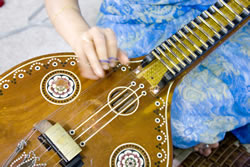Tambura, Veena, Jaw Harp
What do traditional Mississippi delta blues and classical Indian music have in common? Not much you may think but although Alan enjoyed a wide range of music he was particularly captivated by the modal, non hormonic structure that these two genres share. In Alan’s Biography, “Blind Owl Blues” by Rebecca Davis Winters John Fahey offered a possible explanation for Alan’s intense focus on this musical structure:
“According to Fahey’s personal interpretation, certain emotions seemed to be repressed or even missing in Wilson.‘Only if you got to know him real well would you realize that there were certain things that he didn’t feel,’ said Fahey. ‘He didn’t have certain emotions like affection, or love, or even strong hate. He might get mad sometimes, but not half as bad as I can get, or anybody else.’
Fahey felt that this seemingly limited emotional range somehow related to Wilson’s preferences in music. ‘He had a very small repertoire of emotions,’ Fahey mused. ‘It was limited. Also his music was limited to the same kind of emotions. Like, he liked only modal music. It had to be one chord. Like Son House, Skip James, and Robert Pete Williams, he liked a lot. But that was about it.’
Fahey believed that Wilson was attempting, albeit unconsciously, to get in touch with his emotions through music. ‘Another thing was he used to listen to this stuff intensely,’ said Fahey. ‘And then come over and give us a report, like he was a newspaperman. And, about who he liked. And he took this very seriously. And, of course, we all liked lots of other musicians, all kinds of music. And he would speak as a professor frequently. He did that. And I think he was trying to find his emotions. Yeah, and he was looking for his emotions in his music.’ ”
As a member of Alan’s family I would like to offer my own insight into what Rebecca rightly referred to as his “seemingly” limited emotional range. Certainly he had the emotions required to feel a strong longing for a romantic relationship; to cry when rejected by a woman; to study, in detail and with wonderment, his niece’s tiny fingers as she sat in his lap; and to worry obsessively about the degradation of our environment. He felt the emotional pain of his isolation acutely enough to self medicate with drugs and alcohol. It is well established that he suffered from anxiety and depression which run in his family. What also can be found on his mother’s side of the family are autism spectrum disorders. I believe that Alan had some degree of Aspergers. These “disorders” weren’t well understood or recognized in his time so he was dismissed as brilliant but a little odd. I’m sure it caused him much pain, though, not to have the emotional where-with-all to relate to others within standard social norms. Unfortunately he was born too soon to benefit from what is known now about early interventions for ASD’s and the diagnosis and treatment of related anxiety/ depression disorders.
- Heidi Galgowski, Alan’s 1/2 sister (mother’s side)
Veena
 Click picture for Definition of the Veena |
Alan plays Veena Raga 1 |
Jaw Harp
 Click Picture for Definition from Wikipedia, the free encyclopedia |
Jaw Harp Raga |
